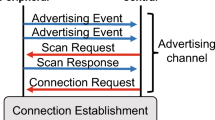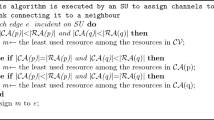Abstract
In RFID systems, wireless communication among readers and tags is subject to electromagnetic interference. In particular, when several readers work closely, forming so-called dense reader environment, reader-to-reader collisions may occur. Several anti-collision protocols have been proposed in the literature to address this issue. Distributed color selection (DCS) and Colorwave are two effective state-of-the-art protocols, based on time division multiple access (TDMA). DCS provides great fairness, but it is not adaptable to changes in network topology, penalizing the throughput of the network. Colorwave is an enhanced version of DCS offering more flexibility. Moreover, a general probabilistic approach has been suggested for solving collisions in TDMA protocols and, in particular, it has been applied to DCS. In this work, the probabilistic method is implemented in the collision resolution routine of Colorwave and its effects are analyzed, confirming the validity of this mechanism for TDMA protocols. As proved by simulation results, the probabilistic approach can be adopted to improve throughput or fairness, without adding any other requirement.















Similar content being viewed by others
References
Bernardi, P., Demartini, C., Gandino, F., Montrucchio, B., Rebaudengo, M., Sanchez, E. R. (2007). Agri-food traceability management using a RFID system with privacy protection. In Proceedings of the 21st international conference on advanced networking and applications (AINA)), (pp. 68–75) doi:10.1109/AINA.2007.29.
Birari, S., Iyer, S. (2005). PULSE: A MAC protocol for RFID networks. In Embedded and ubiquitous computing—EUC workshops, lecture notes in computer science, vol. 3823, (pp. 1036–1046). Springer, Berlin Heidelberg doi:10.1007/11596042_106.
Bueno-Delgado, M., Ferrero, R., Gandino, F., Pavon-Marino, P., Rebaudengo, M. (2013). A geometric distribution reader anti-collision protocol for RFID dense reader environments. IEEE Transactions on Automation Science and Engineering, 10(2), 296–306. doi:10.1109/TASE.2012.2218101.
Bueno-Delgado, M., Pavon-Marino, P., De-Gea-Garcia, A., Dolon-Garcia, A. (2012). The smart university experience: An NFC-based ubiquitous environment. In Proceedings of the 6th international conference on innovative mobile and internet services in ubiquitous computing (IMIS), (pp. 799–804) doi:10.1109/IMIS.2012.110.
Bueno-Delgado, M., Vales-Alonso, J., Angerer, C., Rupp, M. (2010). A comparative study of RFID schedulers in dense reader environments. In: Proceedings of the IEEE international conference on industrial technology (ICIT) (pp. 1373–1378) doi:10.1109/ICIT.2010.5472512.
Buyurgan, N., Hardgrave, B.C., Lo, J., Walker, R.T. (2009). RFID in healthcare: A framework of uses and opportunities. International Journal of Advanced Pervasive and Ubiquitous Computing, 1(1) doi:10.4018/japuc.2009010101.
Engels, D., Sarma, S. (2002). The reader collision problem. In Proceedings of the IEEE international conference on systems, man and cybernetics, vol. 3, (pp. 1–6) doi:10.1109/ICSMC.2002.1176117.
Eom, J. B., Yim, S. B., Lee, T. J. (2009). An efficient reader anticollision algorithm in dense RFID networks with mobile RFID readers. IEEE Transactions on Industrial Electronics, 56(7), 2326–2336. doi:10.1109/TIE.2009.2021869.
ETSI (2011). Electromagnetic compatibility and radio spectrum matters (ERM); Radio frequency identification equipment operating in the band 865 MHz to 868 MHz with power levels up to 2 W; Part 1: Technical requirements and methods of measurement. EN 302 208-1 V1.4.1.
Ferrero, R., Gandino, F. (2011). Degree distribution of unit disk graphs with uniformly deployed nodes on a rectangular surface. In: 6th international conference on broadband and wireless computing, communication and applications (BWCCA), (pp. 255–262) doi:10.1109/BWCCA.2011.38.
Ferrero, R., Gandino, F., Montrucchio, B., Rebaudengo, M. (2012). A fair and high throughput reader-to-reader anticollision protocol in dense RFID networks. IEEE Transactions on Industrial Informatics, 8(3), 697–706. doi:10.1109/TII.2011.2176742.
Ferrero, R., Gandino, F., Zhang, L., Montrucchio, B., Rebaudengo, M. (2013). Simulating reader-to-reader interference in RFID systems. In Proceedings of the 9th international Symposium on frontiers of information systems and network applications (FINA). (pp. 1063–1069) doi:10.1109/WAINA.2013.90.
Galiotto, C., Cetin, K., Frattasi, S., Marchetti, N., Prasad, N., Prasad, R. (2011). High fairness reader anti-collision protocol in passive RFID systems. In: Proceedings of the IEEE international conference on RFID, (pp. 113–120). doi:10.1109/RFID.2011.5764610.
Gandino, F., Ferrero, R., Montrucchio, B., Rebaudengo, M. (2011). Probabilistic DCS: An RFID reader-to-reader anti-collision protocol. Journal of Network and Computer Applications, 34(3), 821–832. doi:10.1016/j.jnca.2010.04.007.
Gandino, F., Ferrero, R., Montrucchio, B., Rebaudengo, M. (2013). DCNS: An adaptable high throughput RFID reader-to-reader anti-collision protocol. IEEE Transactions on Parallel and Distributed Systems, 24(5), 893–905. doi:10.1109/TPDS.2012.208.
Ho, J., Engels, D., Sarma, S. (2006). HiQ:A hierarchical Q-learning algorithm to solve the reader collision problem. In: Proceedings of the international Symposium on applications and the internet workshops (SAINT), (pp. 88–91) doi:10.1109/SAINT-W.2006.20.
Hou, J.L., Chen, T.G. (2011). An RFID-based shopping service system for retailers. Advanced Engineering Informatics, 25(1), 103–115. doi:10.1016/j.aei.2010.04.003.
Iyer, A., Rosenberg, C., Karnik, A. (2009). What is the right model for wireless channel interference?. IEEE Transactions on Communications, 8(5), 2662–2671. doi:10.1109/TWC.2009.080720.
Jain, R., Chiu, D. M., Hawe, W. (1984). A quantitative measure of fairness and discrimination for resource allocation in shared computer systems. DEC Technical Report 301 cs.NI/9809099.
Ni, L. M., Liu, Y., Lau, Y. C., Patil, A. P. (2004). LANDMARC: Indoor location sensing using active RFID. Wireless Networks, 10(6), 701–710. doi:10.1023/B:WINE.0000044029.06344.dd.
Waldrop, J., Engels, D., Sarma, S. (2003). Colorwave: An anticollision algorithm for the reader collision problem. In: Proceedings of the IEEE international conference on communications, vol. 2, (pp. 1206–1210) doi:10.1109/ICC.2003.1204562.
Zhang, L., Ferrero, R., Gandino, F., Rebaudengo, M. (2012). A comparison between single and additive contribution in RFID reader-to-reader interference models. In: Proceedings of the 6th international conference on innovative mobile and internet services in ubiquitous computing (IMIS) (pp. 177–184) doi:10.1109/IMIS.2012.122.
Acknowledgments
This work has been partially supported by the grant “Nano-materials and -technologies for intelligent monitoring of safety, quality and traceability in confectionery products (NAMATECH)” from Regione Piemonte.
Author information
Authors and Affiliations
Corresponding author
Rights and permissions
About this article
Cite this article
Ferrero, R., Gandino, F., Montrucchio, B. et al. Improving Colorwave with the probabilistic approach for reader-to-reader anti-collision TDMA protocols. Wireless Netw 20, 397–409 (2014). https://doi.org/10.1007/s11276-013-0611-z
Published:
Issue Date:
DOI: https://doi.org/10.1007/s11276-013-0611-z




